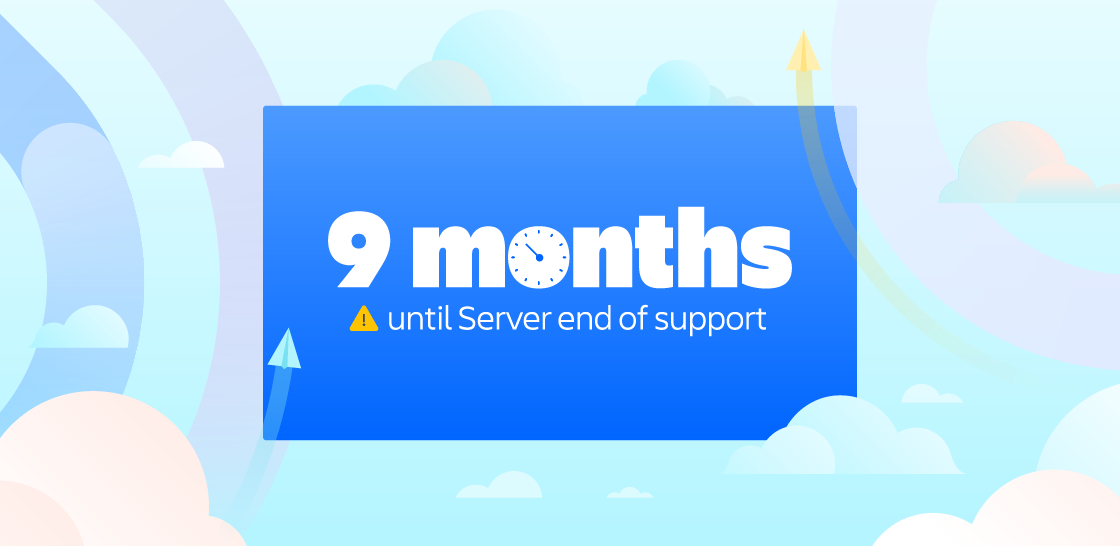Considering cloud? Server end of support is 9 months away
Build a winning plan with our latest cloud migration guidance.
Are you prepared for the end of Atlassian Server support on February 15, 2024? With the countdown clock ticking, now is the time to start a pre-migration assessment. Cloud migrations typically take nine months on average, so it’s essential to start planning now. And to make your move to cloud as seamless as possible, we’ve made the migration process easier than ever before.
In this post, we’ll unpack why pre-migration assessments are critical, how we’ve improved the migration process, and what you can do to get started.
Why a pre-migration assessment is the best way to start building your plan
Migrating to cloud is a considerable change. While you’re getting the very best of Atlassian – a platform that evolves with you, seamlessly integrates with your tools, and gets smarter and faster every day – it’s quite different from our on-premise offerings. Some product features will vary, select apps may not be available or may function differently, and security and compliance become a shared responsibility. This is why thorough evaluation and planning are critical.
Think of it like moving into a new home. With a new floor plan, you may need new furniture, decide to donate old items, or even hire movers so that you can focus on other tasks. While all the planning can feel like a lot of work, it pays off once you can settle into your new space.
In the same vein, we’ve found that customers who invest more time in the evaluation and planning phase, carefully analyzing and strategizing key migration considerations, see up to a 20% reduction in migration time.
To help you evaluate the key differences and build a successful plan, we developed a new pre-migration assessment guide.
Your packing list – the keys to a successful assessment
To support you on your journey, we created a new guide to help you evaluate the top prerequisites and streamline your move to cloud. This guide includes the six key areas for a successful pre-migration assessment:
- Apps: Your apps, integrations, and customizations are integral to making teams more productive. And they’re often the most time-consuming and trickiest parts of building your migration plan. You’ll want to determine the apps you’ll need in cloud and identify alternatives if they aren’t available, review security requirements for those cloud apps, and understand the migration path for each of them.
- Security and compliance: Your requirements won’t change if you move to the cloud, but the way you approach them will. Moving from on-premise to cloud means the responsibility shifts from solely you and your team to a shared responsibility between you and Atlassian. Of course, this is part of what makes cloud such a great choice – you can spend less time on administrative upkeep, since we take on some of that work for you. But we also appreciate that many of our customers have strict security and compliance requirements, which can make that transition to a shared responsibility more difficult to navigate.
- User management: You’ll also need to account for your user migration and identity and access management setup in cloud. Involving your IT or identity team early on in the process will help you fully understand your current identity landscape and compliance requirements. This approach can help your organization stay aligned on its cloud IAM strategy.
- Performance: Evaluating your data size and shape before your migration is critical because the more data you need to migrate, the longer and more complex your migration can become. Cleaning up your data before running a test migration can result in a smoother migration, fewer performance issues, and productivity gains in cloud.
- Cloud product differences: It’s also essential to map out the key differences between self-managed products and cloud. By creating a list of functionality differences, you’ll be aware and prepared with the information you need to enable your teams once you’ve made the move.
- Migration team: While you’ll have project management support and guidance from your Atlassian cloud migration manager, you may find that you need additional support in areas like planning your migration, choosing a strategy and tool, or technical support during testing or production migration.
If you’ve assessed your migration prerequisites and determined Cloud doesn’t meet your requirements yet, we recommend upgrading to Data Center. Check out the Data Center migration guide to learn how to easily upgrade to Data Center.
Migrations just got a whole lot easier
Once you’ve evaluated those key areas for a successful migration and you have a plan in place, you’ll be well prepared to begin your migration journey, which is now easier than ever. Thanks to the experiences shared by thousands of customers who’ve already made the move, we’ve learned a lot about the migration process and how we can make it better. In fact, we’re continuing to invest in the following areas to make the journey as seamless as possible:
- Scalability and reliability: We’ve been heavily invested in improving the scalability and reliability of our migration tooling to increase migration speed, performance, and overall success rate. For example, the Jira Cloud Migration Assistant allows customers to migrate all their data at once, in addition to the existing project-by-project migration capability. Migrating customers can also pre-load users, groups, attachments, and inactive/archived projects and spaces, which can reduce migration downtime by 80-90%!
- Experience: Our teams are also focused on making our migration tools more intuitive, which will make migrating faster and easier. For instance, a common challenge we’ve seen is identifying invalid and duplicate user email accounts in Jira. We solved this by enhancing JCMA’s preparation capabilities, allowing you to identify potential issues in your user base prior to migrating and remediate them, in tool, with just a few clicks.
- Enterprise success: Lastly, we’re investing in improving enterprise migration success by automating parts of the process to reduce time-to-migrate and give you clear guidance. To start, we’ve launched an EAP to automate the assessment that evaluates the shape and size of the data customers are migrating. This will allow us to help provide recommendations on how to test and clean up your instance before migrating.
These are just a few of the ways we’re improving migrations – we’re not stopping there. Check out The Atlassian Migration Program (AMP) to stay up to date on the latest migration guidance and best practices.
And if you’re considering Data Center as a path because cloud doesn’t meet your requirements yet, check out this blog to learn more about how to upgrade and the additional features you’ll unlock in doing so.
How to get started
To start assessing your migration prerequisites, visit our new step-by-step guide, which will lead you through key considerations for a successful pre-migration assessment.
If you have any questions or want expert advice on how to build your migration plan, we’re here to help along the way. If you’re looking for additional expertise and hands-on support, get in touch with a Solution Partner from our network. You can also join our AMP Community Group to get advice from peers and experts.
Lastly, don’t miss out on some limited-time offers. Through May 15th, 2023, we’re offering a free 12-month cloud migration trial to explore cloud and test your migration. When you’re ready to migrate, we encourage exploring eligibility for step-up credits to avoid losing the value of your unused server maintenance. And for the additional complexity enterprise organizations face, save on costs and avoid double paying with dual licensing and loyalty discounts. Loyalty discounts will be available until June 30th, 2023, so lock in a 20% discount in the next couple months before they end.

